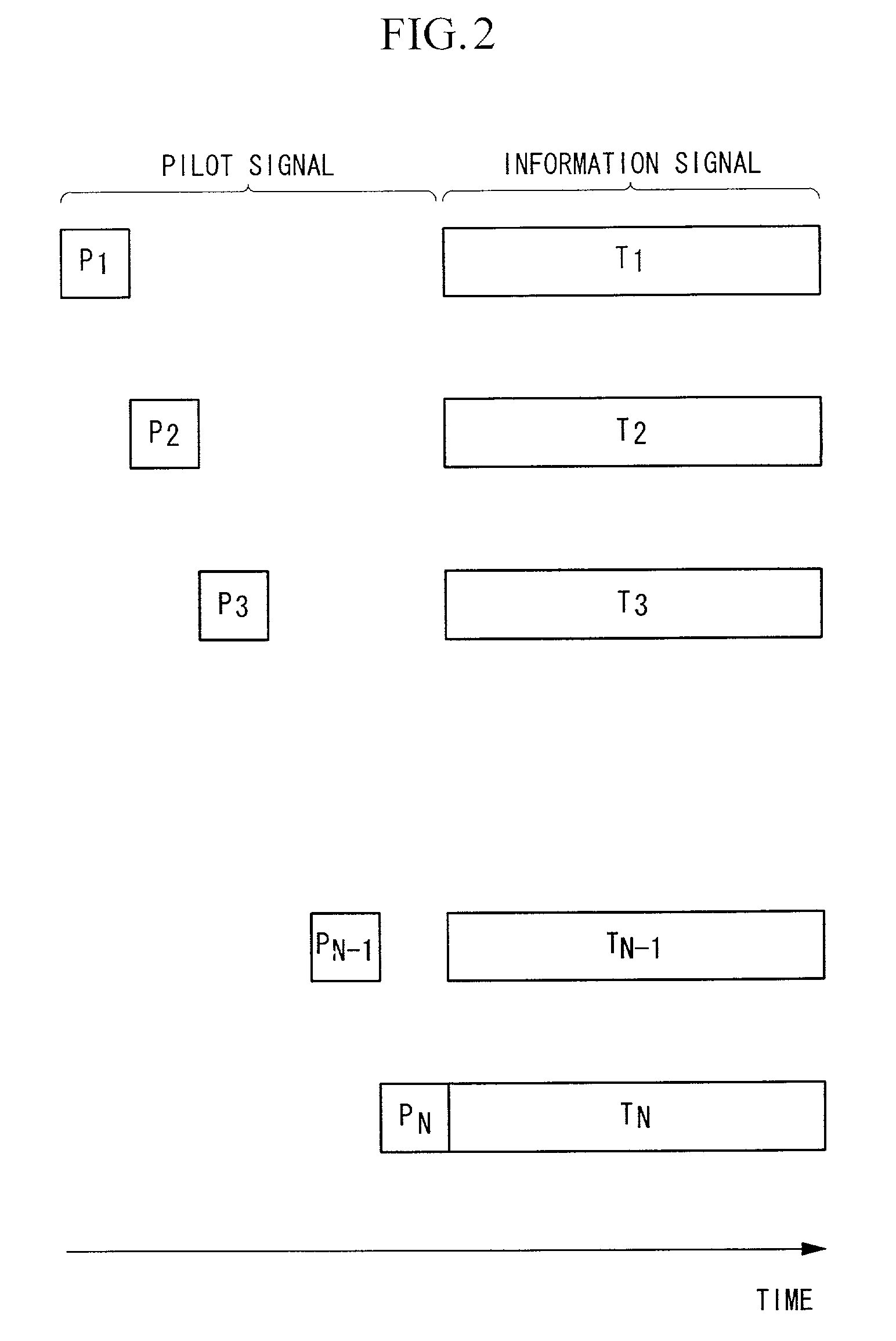OFDM signal communication system, OFDM signal transmitting device and OFDM signal receiving device
a signal communication system and signal technology, applied in the field of orthogonal frequency division multiplexing (ofdm) signal communication system, can solve the problems of difficult realization of conventional transmitter-receiver in the mimo channel, extremely large signal processing capability, and difficulty in realizing effective equalizer, so as to reduce power consumption, increase the hardware size of the device, and increase the power consumption
- Summary
- Abstract
- Description
- Claims
- Application Information
AI Technical Summary
Benefits of technology
Problems solved by technology
Method used
Image
Examples
first embodiment
[0074]A block diagram of an OFDM signal communication system according to a first embodiment is shown in FIG. 1. In this embodiment, the OFDM signal communication system comprises N OFDM signal transmitting device which use the same radio frequency, equipped with two or more N transmitting antennas and connected to each of the antennas, and N OFDM signal receiving device which use the same radio frequency, furnished with N receiving antennas and connected to each of the antennas.
[0075]The construction and operation of the preferred embodiment of FIG. 1 will be described in detail. In this embodiment, N OFDM modulators 1-1 to 1-N are arranged corresponding to N transmitting antennas 5-1 to 5-N. In the OFDM modulators 1-1 to 1-N modulation of the subcarrier and inverse Fourier transformation is performed. To these OFDM modulators 1-1 to 1-N, common OFDM symbol timing is supplied from an OFDM symbol timing control circuit 2.
[0076]Transmission information signals T1 to TN are combined o...
second embodiment
[0111]Next is a description of a second embodiment of the present invention using FIG. 3. In order to improve the performance under fading, in general, OFDM is used combining forward error correction and interleaving. An embodiment with forward error correction and interleaving combined is shown in FIG. 3.
[0112]In FIG. 3, the transmission information signals T1 to TN are subjected to be encoded for forward error correction in forward error correction encoders 15-1 to 15-N, and are then subjected to be interleaved in interleavers 16-1 to 16-N in the subcarrier domain, that is in the frequency domain. This is performed in order to avoid successive errors due to depression of the level (notching) in a certain frequency neighborhood, and obtain large performance improvement by forward error correction.
[0113]In the receiver, the demodulation output is subjected to be deinterleaved, as a reverse operation to the interleaving of the transmitter, in deinterleavers 17-1 to 17-N, and is then ...
third embodiment
[0115]In the construction of FIG. 3, in the case of comparatively long delay fading (refer to FIG. 4B), successive errors do not occur and hence satisfactory characteristics are obtained. However in the case of short delay fading, the fading period on the frequency domain is long as shown in FIG. 4A, and hence the notch becomes wide, and in this part, successive errors are likely to occur, and forward error correction gain is small.
[0116]The third embodiment of the present invention will be explained with reference to FIG. 5. This embodiment is an embodiment for improving the lowering of the forward error correction gain as described above.
[0117]The transmission information signals T1 to TN are subjected to be encoded for error correction encoding in the forward error correction encoders 15-1 to 15-N as shown in FIG. 5, and are then interleaved both in the subcarrier domain (frequency domain) and in the transmitting antenna domain (space domain) in the interleaver 16, to thereby aff...
PUM
 Login to View More
Login to View More Abstract
Description
Claims
Application Information
 Login to View More
Login to View More - R&D
- Intellectual Property
- Life Sciences
- Materials
- Tech Scout
- Unparalleled Data Quality
- Higher Quality Content
- 60% Fewer Hallucinations
Browse by: Latest US Patents, China's latest patents, Technical Efficacy Thesaurus, Application Domain, Technology Topic, Popular Technical Reports.
© 2025 PatSnap. All rights reserved.Legal|Privacy policy|Modern Slavery Act Transparency Statement|Sitemap|About US| Contact US: help@patsnap.com



